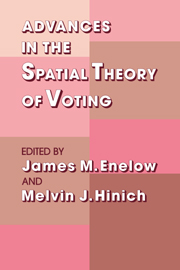Book contents
- Frontmatter
- Contents
- Foreword
- ADVANCES IN THE SPATIAL THEORY OF VOTING
- 1 Introduction
- 2 Multiparty Competition, Entry, and Entry Deterrence in Spatial Models of Elections
- 3 Heresthetic and Rhetoric in the Spatial Model
- 4 Spatial Strategies When Candidates Have Policy Preferences
- 5 A Decade of Experimental Research on Spatial Models of Elections and Committees
- 6 Candidate Uncertainty and Electoral Equilibria
- 7 The Theory of Predictive Mappings
- 8 Multicandidate Spatial Competition
- 9 The Setter Model
- Author Index
- Subject Index
2 - Multiparty Competition, Entry, and Entry Deterrence in Spatial Models of Elections
Published online by Cambridge University Press: 05 March 2012
- Frontmatter
- Contents
- Foreword
- ADVANCES IN THE SPATIAL THEORY OF VOTING
- 1 Introduction
- 2 Multiparty Competition, Entry, and Entry Deterrence in Spatial Models of Elections
- 3 Heresthetic and Rhetoric in the Spatial Model
- 4 Spatial Strategies When Candidates Have Policy Preferences
- 5 A Decade of Experimental Research on Spatial Models of Elections and Committees
- 6 Candidate Uncertainty and Electoral Equilibria
- 7 The Theory of Predictive Mappings
- 8 Multicandidate Spatial Competition
- 9 The Setter Model
- Author Index
- Subject Index
Summary
We cannot have observations of deaths without observations of births.
Riker (1976: 99)Political theories based on the spatial model have enjoyed a dual existence. As reflected in the title of Duncan Black's (1958) famous volume, the spatial model provides a foundation for the analysis of electoral phenomena and committee decision making. It does this by providing an abstract characterization of the outcomes and preferences common to electoral and committee choice. In each setting, outcomes are represented by points in a Euclidean space. Preferences over outcomes are represented by voter (legislator) utility functions defined on points in this space. Whether an actor is called a “voter” or “legislator,” and whether a point in the space is designated a “voter's [legislator's] preferred policy,” the “policy of a candidate,” or a “legislative bill,” is little more than a labeling convention. It indicates the substantive domain of interest to the researcher.
The spatial theory of elections and the spatial theory of committees, however, have followed different paths of development as subfield-specific scholars have charted distinctive research agendas. And yet, a question pursued in one subfield – for example, is there a spatial location for a candidate that cannot be beaten by a candidate at any other location? – typically has a dual in the other subfield – for example, is there a motion that cannot be successfully amended? It is from this perspective that we explore multicandidate competition and entry in spatial models of elections. We see these phenomena as duals to agenda-setting activities in legislatures.
- Type
- Chapter
- Information
- Advances in the Spatial Theory of Voting , pp. 12 - 45Publisher: Cambridge University PressPrint publication year: 1990
- 7
- Cited by



